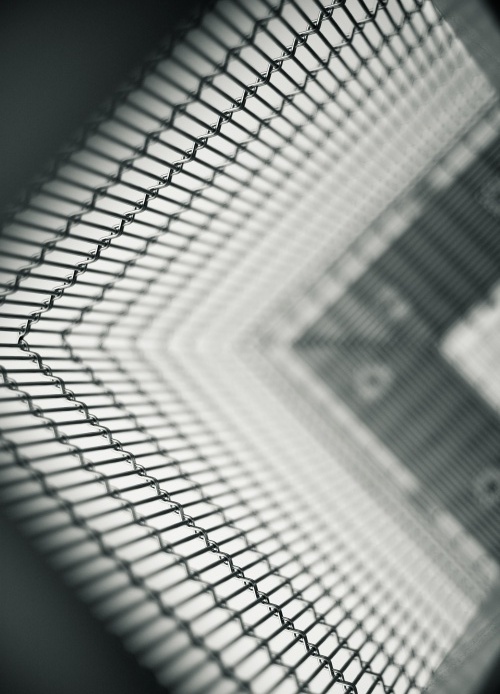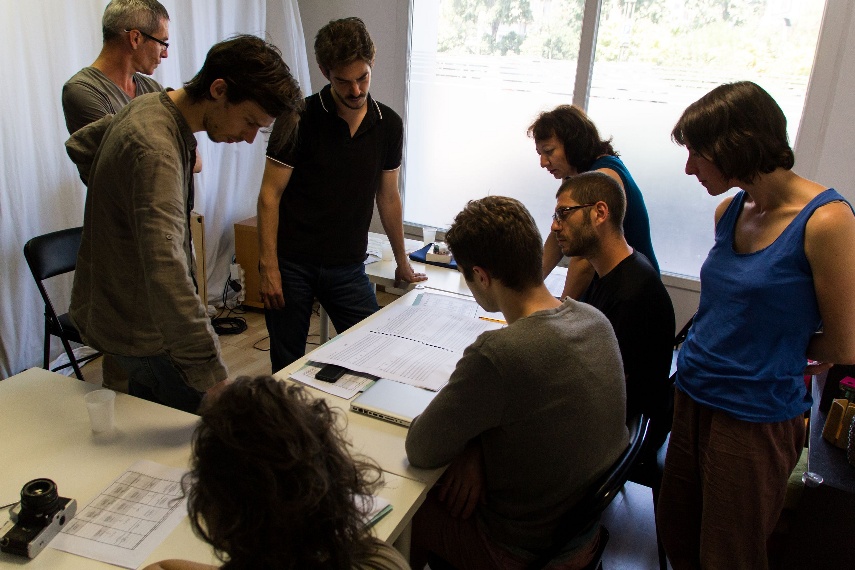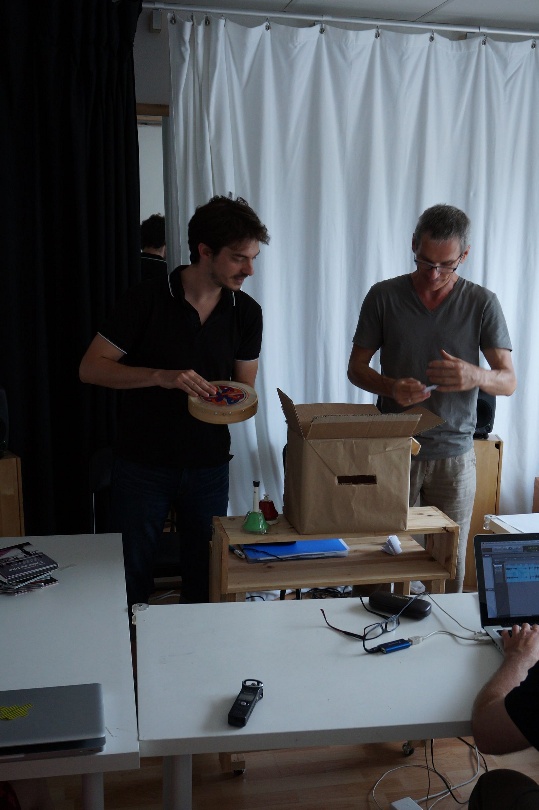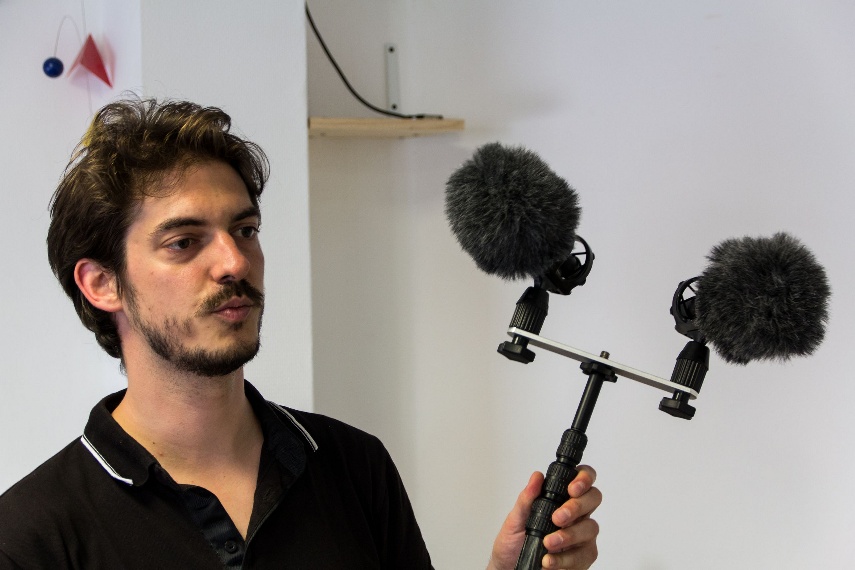 archives: Electroaoustic music workshops - Summer 2014
archives: Electroaoustic music workshops - Summer 2014
The artistic collective
hapax, in partnership with collective éOle, organizes in Toulouse (July 15th 2014-July 19th 2014)
an electroacoustic music summer course (see details infra).
Pieces by course participants will be performed during the festival Novelum 2014: europa #2 (November 2014, Toulouse). Admission is based on application file.
Aims
Deepen one’s knowledge of the electroacoustic repertoire and its different compositional approaches. Produce a work
to be played live within the scope of the Novelum festival 2014 - Europa #2.
Audience
Advanced students. Young composers.
Admission based on file evaluation.
Presentation
Each day, a composer will tackle a particular aspect of compositional
work through the analysis of works from the repertoire or of his own
creation (2h/day). Workshops will be proposed by Jacky Mérit and Guillaume Hermen,
in order to provide you an accompaniment for your creation (3h /
day).
You will also be allowed access to the studios at the beginning and at
the end of each day (min : 1h30 /day for each student).
Each student will have to produce an electroacoustic work in relation
with the 2013 - 2014 Novelum festival theme: Europe. The works will
be played live on November 13th, 2014 at the Espace Musical de la
Digue. This performance will allow you, possibly, to receive an aid
from the Encouraging the first public performance Fund from the
SACEM.
Period:
From the 15th to the 19th of July 2014.
Duration:
5 days.
Place:
Espace Musical de la Digue, Toulouse, France
Languages:
French, English.
Tuition fees:
300€.
Contents, contributors:
“Phonography: compositional object”, by Bertrand Dubedout
“Beyond Pierre Schaeffer’s concern regarding the possible semantic overload of a sound object, works such as
L’EXPERIENCE ACOUSTIQUE by François Bayle, HETEROZYGOTE by Luc Ferrari or HYMNEN by Karlheinz Stockhausen, to
quote only a few examples, have bestowed upon phonography, each in their own manner, a genuine status of compositional
object. Furthermore, the miniaturization of the recording tools renders the phonographic practice accessible to everyone.
Facing what becomes an authentic stake in today’s music, this workshop will study the auditive criteria and compositional
strategies that could be elaborated, as much for the acousmatic field as in that of mixed music, through excerpts from two of
Bertrand Dubedout’s works : NARA (2001) and LES CHEVEUX DE SHIVA (2013).”
Born in 1958 in Bayonne, France, Bertrand Dubedout pursued higher musical studies first at the University of Pau, then at the Conser-
vatoire National Supérieur de Musique of Paris, where he was in the department of electro-acoustic composition and musical research under
Pierre Schaeffer and Guy Reibel, receiving his Prize in Composition in 1981. Concurrently, he studied musicology at the University of Paris-VIII
and at the Center of Polyphonic Studies in Paris. Currently teacher of electroacoustic music at the Conservatoire à Rayonnement Régional of
Toulouse, he is the founder of the Ensemble Pythagore and artistic co-director of the collectif éOle (studio and production center in Odyssud
Blagnac) and the Festival Novelum.
In 1997, the Sacem has awarded to Bertrand Dubedout the “Claude Arrieu” Prize. In 1999, he has been composer selected to enter the
Villa Kujoyama in Kyoto, Japan (Afaa/ French Foreign Office programme). His instrumental and vocal works are published by Gérard Billaudot
Éditeur, Paris. Several CDs published by L’empreinte digitale / Nocturne, MFA - Radio France, MOTUS, Metamkine, Skarbo, Bis, éOle Records.
“The influence of electroaoustic practising on instrumental composition”, by Pierre Jodlowski
“The development of a musical writing based upon electroacoustic means defines a singular frame both in the imagination
and in the concrete achievement.[...] Initially, resorting to electronics could be simply considered as an extension of the mus i -
cal field, offering it the possibility of a spectral prolongation and a work on spatialization. Yet, the electronic possibilities are
much wider than a mere prolongation of the instrumental thought ; they also have a proper History, initiated by the electric
revolution from the 1950’s.[...]”
Pierre JODLOWSKI is a composer, performer and multimedia artist, at the crossroads of acoustic and electric sound. He is co-artistic director of
éOle (based in Odyssud - Blagnac) and Novelum festival in Toulouse.
He has collaborated with ensembles Intercontemporain, Ictus, KNM, Ars Nova, Proxima Centauri, Court-circuit, les éléments and various interna -
tional soloists. He also collaborates with musicians such as J. Geoffroy, C. Jullion, W. Latchoumia, for works and research on the new instru-
ments capacities. He recently produced a trio with R. Auzet and M. Portal a duo with drummer A. Babel and different projects with musicians
from improvised music scene in France and Poland. His work led him to develop collaborations with visual artists among whom the stage desi -
gner Christophe Bergon. He has received commissions from IRCAM, Ensemble Intercontemporain, the French Ministry of Culture, Akademie der
Künste (Berlin), GRM, the Donaueschingen Festival, Radio France, Siemens Foundation, the Opera of Toulouse, the European project INTEGRA,
the Royaumont Foundation, Venice Biennale music festival.
Winner of several international competitions, he won two SACEM Prizes in 2002 and 2012, and was in residence at the Academy of the Arts of Berlin in
2003-2004. His works and performances are broadcast in key places devoted to contemporary music in France, Europe, Canada, China, Japan and the USA.
His works are the subject of several CD and video recordings on the labels éOle - RECORDS and Kaïros. He is living in France and Poland.
“Symmetry cracks : figures and sound fluxes. Genesis and alteration of figures within electroacoustic music”, by Gaël Tissot
“On its own, perhaps a form is of no particular interest. What is interesting, what a form truly says, is a family into which it
is incorporated, a group in which it can be placed. They depend on the choice of the one that wants to see”, Jean Dhombres,
mathematician and mathematics historian.
Composing mixed or electroacoustic music is a constant questioning on the appearance of figures in the continual flux of the
sound recording. How to give birth to, or highlight these figures. On the contrary, how to conceal them, cloud them. How to
consider giving intelligibility to the listening based upon these elements.
These questions will provide food for thought through practice. The following tools of multiplexing sounds (graphic palette
paired to the Max/MSP software), dynamic filtering , the genesis of figures from gestures, etc., will thus be approached.”
Gaël Tissot discovered music through the study of piano. From 2002 onwards, during his musicology studies at the university of Toulouse, he
attends the composition course of the Conservatory in Bertrand Dubedout’s class as well as Fançois-Michel Rignol’s piano perfecting class in
Perpignan.
Author of a thesis on the electroacoustic music of François Bayle and his relation to the visual field, he also completed his composer training at
the Centre International de Recherches Musicales in Nice (framework in which he carried out a 3-month residency at the university of Berkeley
in California) and at the Conservatoire National Supérieur de Musique of Lyon, before joining, in 2011, the group of éOle composers (Toulouse).
From his music, as well instrumental as electroacoustic, emanates a work on plasticity, a play on the outlines of sound and the noticeable forms
that can flow from it. He is also the author of numerous international musicological publications, and his music is played in France as well as
abroad (Nuits bleues, Tage für neue Musik Darmstadt, festival Occitània, université de Cologne...).
Gaël Tissot founded the artistic collective hapax in 2013, and he is currently his artistic director.
“Can Sound still have meaning ?”, by Jacky Mérit
“One must reconcile to the obviousness of digital manipulations : morphologically, no matter what manipulations, the
sound seems to have been continually present... environmental sound, instrumental, electronic... Texture, roughness, fric -
tion, density... are no longer to be considered as sound epiphenomena, accidents, exotic peculiarities or connoted detours.
It can be the sound’s way of being, if one wants to oblige oneself to reconsider the causality relations within sound.
Outside of the frame of the object, we must conceive a multiphonic presence without measurable link to the identity of the
sound’s source. We must learn how to develop a widened perceptive approach, aimed at the details and ambiguities of sound.
An approach of attentive listening to one’s own tremor and to the invasion, capable of simultaneously receiving meanings
and contradictory affects.”
He discovers electroacoustic music during his studies at the Fine Arts of Tours, in 1989 and has since then built up a self-taught musical training.
Today he centers his research around sound and tries to apply his plastic artist methods to his compositions. Originally, based upon the
exploration of matter and narration, he work presently aims not only at the plastic and architectural dimension of sound, but also at the notion
of polyphony of space and meaning. He expresses himself through a type of music devoid of the canons of harmony, starting from sound - this
illness of beauty - to come to an alternative experience by attempting to define a new geography.
His works are mainly destined to live concerts, but also to drama, dance, video, sound and multimedia installations.
He is the winner of several electroacoustic music contests (see french version).
His works are played in France and abroad by different institutions and festivals (see french version).
“Constructing time”, by Guillaume Hermen
“This workshop offers dedicated students the opportunity to delve into the issue of rhythm and focus on the weight of
space, tone and heights in our perception of time. Together we will analyze samples of various temporalities taken from the
music of virtuoso of time construction like Debussy, Webern, Feldman, Steve Coleman or Pierre Henry, and from traditional
Indian and Central African music.”
After studies in sound techniques for film, Guillaume Hermen entered the Toulouse Conservatoire and studied electroacoustic music composi-
tion with Bertrand Dubetout. There he discovered the liberty in contemporary creation through artists such as Gyorgy Ligeti, John Cage, Jimi
Hendrix, Pierre Henry or John Coltrane. In 2007, he moved to Paris so as to devote his time to composition, becoming first a student of Philippe
Leroux at the Nanterre Conservatoire, and then of Thierry Blondeau at the Blanc-Mesnil Conservatoire. Since 2011, he continues his musical
education at the CNSMDP with Gérard Pesson.
With the performance of his compositions, he established contacts with music ensembles like EIC, Cairn, l’Itinéraire and Tm+ and attends festi-
vals like Novelum, Mance, Futurs, Musiques Démesurées, Licences and Bruits Blancs.
Convinced that the confrontation of various artistic forms is essential in the quest of new artistic languages, Guillaume Hermen has focused his
work on the relationships between sound and gesture, writing and improvisation, real and virtual. He has, amongst others, collaborated with the
choreographer Cheryl Therrien and the musical improviser Sylvain Darrifourcq.




